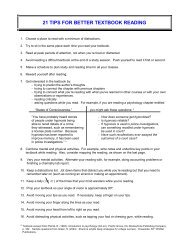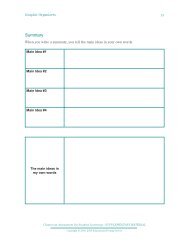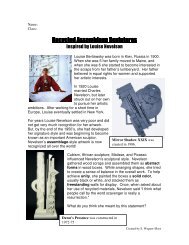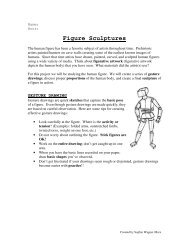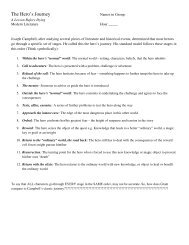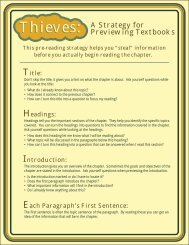You also want an ePaper? Increase the reach of your titles
YUMPU automatically turns print PDFs into web optimized ePapers that Google loves.
Name:Hour: Artists and craftsmen have created ceramic tiles forover 4000 years! Ceramic tiles are both durable andfunctional, making them an excellent choice for theinterior and exterior of buildings. Examples of ceramictile have been found in some of the oldest knownstructures, including the pyramids, and the ruins ofancient Greek cities! Decorative tile work probablyoriginated in the near east. The elaborate patterns helpmake up for the lack of visual interest in the desert.<strong>Islamic</strong> ArtFriday Mosque atHerat in AfghanistanIslam is the religion practiced by an ethnically diversegroup of Muslims all over the world. It is based on thebelief that Allah is the one, and only, Supreme Being.For Muslims, Islam is more than just a religion; it is a way of life and a source ofpolitical and cultural beliefs. Islam began with the prophet Muhammad around622. Although unpopular at first, Muhammad eventually attracted manyfollowers. Today, one fifth of the world’s population believes in Islam!<strong>Islamic</strong> art is highly detailed and elaborate. It ischaracterized by intricate geometric patterns thatare frequently combined with ornate calligraphy. Inaddition to being found in architectural decoration,<strong>Islamic</strong> designs adorn furniture, tapestries,rugs/carpets, ceramic containers, and more. TheMuslim belief that Allah isunique and cannot berepresented with a man oranimal means that humanfigures are absent from<strong>Islamic</strong> artwork. Instead,Muslim artists are expertpattern makers!Mihrab (prayerniche) in Isfahan,Iran, 1354-1355<strong>Tile</strong> fragment from CentralAsia, 14 th CenturyCreated by S. Wagner-Marx
<strong>Tile</strong> Design1. The geometric patterns in <strong>Islamic</strong>art are very complex. Shapes arecombined, interlaced, and duplicatedto create unified and ordered designs.Your first task for this assignment is todesign a tile using geometric linesand shapes. Have the followingguidelines in mind when planning outyour design.• What elements of your designwill be repeated?• How can you incorporatesymmetry into your design?• What geometric shapes willyou use?• Will you include a pattern?Design VocabularyForm: 3-D object or artwork that can beviewed from all anglesSymmetry: type of balance when twohalves of a design are identicalRepetition: design element that occursmore than once, helps achieve unityPattern: regularly repeating decorativedesignTexture: surface treatment, or how anobject feelsGeometric Shape: shapes with regularcontours, and straight edges such assquares, triangles, or circlesUnity: Organization of design so all partscontribute to a coherent wholeUse the following boxes to plan 3 possible designs for your <strong>Islamic</strong> inspired tile:2. Next, transfer and enlarge your bestdesign to a square piece of drawing paper(this will be precut for you and willbecome the template for the sides of yourbox).3. Roll out a slab of clay. Use guide rails tomaintain uniform thickness. Carefullytrace your square piece of paper and cutout your tile with a needle tool.Mosaic Glazed <strong>Tile</strong>, late15th century, Iran4. Use clay tools to incise, or carve, your design from the surface of yourtile. How might you add texture to your tile?Created by S. Wagner-Marx
3. To assemble your slab pieces, you will need to first score the edges thatyou are going to join in a crosshatching pattern. Apply slip to the scoredmarks and carefully join the two slabs. Use even pressure with yourfingers to create a nice seal. You want to avoid trapping air in the seam!4. Roll a small coil with your fingers. Smooth the coil into the inside seamyou just created in step 3 to strengthen it. Check the outside corner. Willyou need to add a small coil to create a smooth edge?5. Continue joining the slab pieces until the box is complete. If you wouldlike, add feet to the base of your box and an appliquéd handle to the lid.Your artwork is now ready to become greenware and be bisque fired.6. Your last step is to decorate your tile box. We will be using coloredunderglazes and clear overglaze to create colorful accents on your tiledesigns!Created by S. Wagner-Marx



